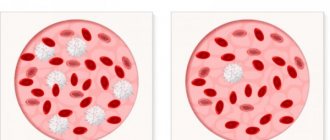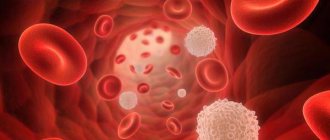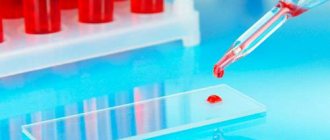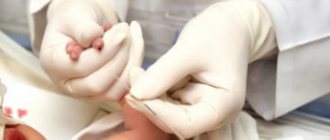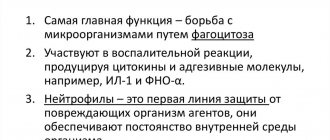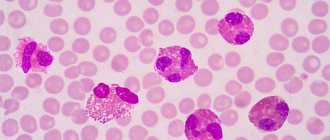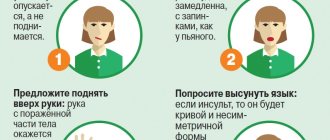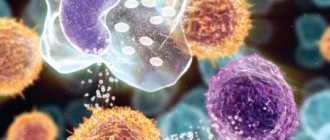The importance of neutrophils in the diagnosis of diseases
Cell characteristics
As mentioned above, neutrophils are a type of granulocytic leukocyte. They belong to this group of white blood cells, since they have granules in their composition, or rather in the cytoplasm. They contain various types of compounds: proteins, enzymes, and so on. They provide functions to neutrophilic leukocytes.
Role in the body
Neutrophils make up the majority of all leukocytes. Everyone knows that white blood cells protect our body. How does this happen?
When a foreign agent enters the body, substances are produced that attract neutrophils to the site of penetration. There, neutrophil leukocytes phagocytose, that is, absorb a foreign agent. The granules contained inside the neutrophil help digest the foreign compound.
The difference between neutrophils and other cells that can “eat” other molecules is their viability after phagocytosis. Neutrophils participate in phagocytosis once in their lives (after which they die), while other macrophages can do this many times.
Thus, this type of leukocyte is one of the first factors in the body’s defense against foreign agents.
Type of neutrophils
There are several types of leukocytes, differing in maturity. Initially, the maturation of this type of leukocyte begins in the same way as others - from a precursor cell. Then, during differentiation, a myeloblast is formed from it, then a promyelocyte. Already at this stage, granules begin to appear in the cells. Next, a myelocyte is formed, then a metamyelocyte. It is also called a young neutrophil.
Under some conditions, young neutrophilic leukocytes can be detected in the peripheral blood.
A band form is formed from the metamyelocyte. It is named after the shape of the kernel at this stage of maturation. The final, mature cell is the segmented neutrophil. It differs from its predecessor in the structure of the nucleus: segments are formed from the so-called rod, connected by constrictions.
What level is considered elevated?
Neutrophils are the largest group of white blood cells, whose main task is to fight pathogens. There are several forms of such leukocytes:
- Young (also called “metamyelocytes” and “myelocytes”) – absent in the normal leukogram.
- Band neutrophils (rods) are young cells, the content of which should not exceed 12% in newborns, 5% in children under 5 years of age, and 4% in children over five years of age. These are the upper limits of normal for this type of neutrophil.
- Segmented - the most numerous neutrophils, which are mature cells.
Their upper limit of normal in childhood is represented by the following indicators:
In a newborn in the first days of life
In infants from the 5th day of life to 1 month
In babies older than 1 month to one year
In children older than one year
In children over five years of age
In children over 10 years old
If the level of neutrophil cells exceeds these levels, it is called “neutrophilia”.
We recommend watching a video where a specialist from one of the capital’s clinics covers the topic of neutrophils in detail:
A slight increase in the percentage of neutrophils occurs during physical or psychoemotional stress, as well as after eating. If the cause of a high neutrophil count is a disease, then the cell level is directly related to disease activity.
Pathological causes of neutrophilia include:
- Active inflammatory processes, for example, arthritis, pneumonia, dermatitis, inflammation of the pancreas, appendicitis and others.
- Bacterial infections, including purulent ones (abscess or cellulitis formation).
- Some viral infections.
- Infections caused by protozoa or fungi.
- Tumor processes.
- Extensive burns.
- Poisoning.
- Diabetes.
- Trophic ulcer.
- Use of certain medications, such as corticosteroids.
- Acute blood loss or hemolysis of red blood cells.
Neutrophils are also detected in increased numbers in the postoperative period.
In addition to increasing the number of neutrophil leukocytes, doctors also evaluate which forms of these cells caused the increase in their percentage. Diagnose:
- Shift of the formula to the left - band cells are increased, and juvenile forms are also present. This result is typical for severe intoxication, purulent infections, anemia (posthemorrhagic or hemolytic), leukemia, and burns. If the displacement is small, it may be caused by intense training or emotional stress.
- The formula shifts to the right - the number of “rods” is low, and the percentage of segmented cells is increased. This pattern is less common than a shift to the left. It occurs with anemia, polycythemia, leukemia and other pathologies.
Watch the episode of Dr. Komarovsky's program about clinical blood tests. In it you will hear answers to many of your questions:
If a child’s blood test shows an elevated level of neutrophils, parents should contact a pediatrician, who will immediately refer the baby for re-examination, because the level of such leukocytes may be determined incorrectly due to non-compliance with the following rules:
- The child must donate blood on an empty stomach. If this is an infant, then he should not receive food 2-2.5 hours before blood sampling. Only a little drinking water is allowed as it does not affect the white blood cell count.
- The child must be calm. It is best for the mother to come with the baby to the blood draw a little in advance, so that the baby can sit in the corridor for a while. This will also eliminate the influence of temperature changes on the result.
- Active physical activity should be avoided immediately before the collection (do not allow the child to run in the corridor of the clinic) and the day before.
If a blood sample was collected following these tips, but leukocytosis is still due to a high level of neutrophils, the doctor will order additional testing. First of all, it will be aimed at identifying an infection or an active inflammatory process.
As soon as the cause of neutrophilia is discovered, the baby will be prescribed the necessary treatment. When the child’s body, with the help of the medications used, copes with the inflammation or infectious process, the level of neutrophil leukocytes also normalizes.
Indications for referral for analysis
- Determination of neutrophil levels can be carried out as part of an annual preventive examination in children and adults. This is a way to identify hidden diseases that do not yet have clinical symptoms.
- A study of the leukocyte content is determined in order to determine whether there is an infectious process in the body. Perhaps this is the main indication for prescribing an analysis of the level of neutrophil leukocytes in the blood. That is, by analyzing the level of white blood cells, we can draw a conclusion about the body’s ability to resist infections. This is an important characteristic of children's health.
- One of the indications for studying the content of this type of cells is the diagnosis of malignant blood diseases. This may be evidenced by the detection of young and blast forms of neutrophils
- A conclusion about the effectiveness of treatment can also be made based on data on the level of neutrophils over time.
Neutrophils in children are increased
An increase in neutrophils in the blood is called neutrophilia or neutrophilia. This phenomenon is observed in diseases such as:
- acute inflammatory diseases (otitis media, tonsillitis, pneumonia, appendicitis, sepsis, peritonitis, etc.);
- purulent diseases (phlegmon, abscess);
- burns 3-4 degrees;
- trophic ulcers;
- hemolytic anemia;
- leukemia;
- myocardial infarction.
Taking corticosteroids increases the number of neutrophils in a child's blood.
How is the level of neutrophils in the blood calculated?
To perform a neutrophil count, blood is required. Any one is suitable for this: taken from a vein or capillary. In newborns, blood may be taken from the heel. The study of the type of white blood cells is called leukocyte count. It is performed during a general clinical blood test (CBC).
This study is most often carried out using a microscope and a special cell counter. The specialist examines the blood smear and counts all the types of cells that he saw. Counts one hundred cells in a smear. Next, writes the result on the answer form.
Staining of smears is used to differentiate different cells from each other. The Romanowsky-Giemsa method is most often used for staining blood smears.
For heavy laboratory workloads, it is possible to count cells using an automatic hematology analyzer. But not all laboratories can be equipped with such devices. Which brings us back to the manual method and the value of experts in the field.
The norm of neutrophils in a child’s blood
This is what the blood test data looks like. In this case, the child is 1 month old and has 13% segmented neutrophils, which is slightly below the norm, and 2% band neutrophils - this is the norm
The normal number of neutrophils in a child depends on his age. These indicators are a part of the leukocyte formula, and if they are within the required limits, then this indicates that the immune system is in perfect order and functioning at the proper level.
The norm of segmented neutrophils from the total number of leukocytes in%:
- in infants from 0 to 1 month - 45-80%;
- norm up to a year from 1 month - 15-45%;
- from 1 year to 13 years - 35-62%.
The norm of band neutrophils from the total number of leukocytes in%:
- in infants from 0 to 1 month - 3-17%;
- from 1 month to a year - 0.5 to 4%;
- from 1 year to 13 years - from 0.7 to 5%.
Important! It is necessary to monitor the composition of the blood on an ongoing basis, since any deviation is an alarming sign, and as you know, the faster the disease is detected, the easier it is to cure it.
We also recommend studying this topic:
Lymphocytes in a child are increased or decreased: causes and consequences of deviations
Do you need any preparation for the analysis?
If the patient wants to get a reliable result of a blood test, then it is necessary to prepare. Moreover, the rules are very simple.
- Blood is donated on an empty stomach. Children under one year of age should not eat for 30–40 minutes before blood sampling. Older people – 3-4 hours.
- emotionally calm before donating blood .
- The level of physical activity also matters. Do not burden yourself or your child with training or sporting events. Even running down a hospital hallway can affect your results.
- There are situations where medications interfere with results . If the patient takes anything, the doctor should be notified so that he takes this into account when interpreting the study results.
Is it worth sounding the alarm?
Like adults, children cannot be 100% protected from inflammatory processes. However, neutrophils, the protective cells of our body, are always on guard and allow dangerous cells, fungi and viruses to penetrate and attack the body. In addition to healing wounds, neutrophils help remove dangerous microorganisms from the body. If segmented neutrophils in children gradually decrease in percentage, this most likely indicates chronic inflammation.
In addition to all of the above, such a situation can be provoked by a bad environmental situation, taking certain medications, severe emotional shock, or stress. At an early age, medications rarely provoke a decrease in neutrophils in a blood test; as a rule, this occurs at a more mature age. If this does happen, then it is better to reduce their dosage or completely abandon their use.
In some cases, the first blood test for segmented neutrophils may show incorrect data, so it is advisable to retake it. It is better to donate blood on an empty stomach and in a calm environment. A decrease in the neutrophil count in a child, among other things, can occur due to decreased immunity, insufficient body weight, or even anemia.
There are patients who have a chronic deficiency of segmented neutrophils. As a rule, by the age of 2-3 years, this process stops and the cell level stabilizes. This process is always easy. Often, with a reduced level of neutrophils, the child feels great. In this case, we can talk about the presence of some deviations that may be caused by heredity.
If a child’s segmented neutrophils are low and lymphocytes are high, this means that the immune system is severely affected and is trying to fight inflammation in all available ways. In this case, a low level of neutrophils in children indicates an infection, and an increased level of lymphocytes indicates the presence of dangerous viruses, problems with the thyroid gland, tuberculosis, and the acute stage of lymphocytic leukemia. In such a situation, you should immediately consult a doctor and conduct a proper examination.
Almost always, a reduced level of segmented neutrophils in a baby cannot be treated. In order to bring the indicators back to normal, doctors try to identify in the early stages the exact causes of changes in the body, overcome them and restore the functioning of the immune system. If the disease is chronic or advanced, the child is treated according to an individual program.
Normal values of neutrophils in the blood in adults and children
Due to different methods for calculating the variety of white blood cells, there are different units of measurement: absolute and relative.
Relative values are the number of cells out of a hundred. Expressed as a percentage.
Absolute values - show a specific number of cells in a liter of blood.
The norms of neutrophils in the blood of adults and children are presented in Table 1.
Table 1. Reference values for neutrophil leukocytes.
| Age group | Absolute values | Relative values | |
| Rod | Segmented | ||
| Less than one year | 1.5 – 8.5 * 10*9/liter | 0,5 – 4 % | 15 – 45 % |
| One year – six years | 1.5 – 8.5 * 10*9/liter | 0,5 – 5 % | 25 – 60 % |
| From seven to twelve years | 1.8 – 8 * 10*9/liter | 0,5 – 5 % | 35 – 65 % |
| Over thirteen years of age Adults | 1.8 – 7.7 * 10*9/liter | 0,5 – 6 % | 47 – 72 % |
Norm
The norm of neutrophils in children differs from that in adults. The indicator is indicated as a percentage and is not tied to gender, but changes only with the age of the child. The study necessarily determines the segmented and band content of neutrophils. Each age group has its own norm.
For example, the norm of band neutrophils for a newborn is 5-12%, after 5 days and up to 5 years of age the norm is from 1 to 5%, and over 5 years the normal index is within 1-4%. As for segmental neutrophils, the absolute number is:
- newborns have rates in the range of 50-70%;
- on the 5th day after birth, the rates decrease to 35-55%;
- in 1 month from the moment of birth the norm is 17-30%;
- a one-year-old child has a norm of 20-35%;
- five-year-old child - 35-55%;
- child 10 years old and older - 40-60%.
Important information: What are B-lymphocytes in a blood test?
A normal number of particles protects the child’s body from various types of infections, because are mobile particles and when an inflammatory focus occurs they are directed towards it.
The most common causes of increased neutrophil levels in the blood
Band shift
There is such a thing as a shift of the leukocyte formula to the left. This means that the ratio between mature and young forms of neutrophil leukocytes changes towards an increase in the level of the latter.
The shift can be of varying degrees. The result of the analysis will depend on the increase in which forms the shift occurs: stab, juvenile, and so on.
The condition when neutrophils are increased in the blood of a child and an adult is called neutrophilosis.
Band neutrophils may be elevated in the following cases:
- infectious process in the body. Due to the lack of neutrophils, signals are sent to the bone marrow, where cell maturation occurs, to produce new “fighters”. Therefore, not fully matured cells enter the bloodstream;
- blood loss stimulates the bone marrow to synthesize all blood cells, not just leukocytes;
- after intense physical activity and stress;
- after operation;
- pregnancy.
Still, the main reason for the high number of these types of leukocytes is the inflammatory process, which they intensively fight.
With malignant pathologies, almost all forms of neutrophil maturation, including blast cells, can appear in the blood.
High level of segmented neutrophils
Segmented neutrophils are mature cells.
An increase in their number in the blood will be called a shift in the leukocyte formula to the right. There are a number of conditions when segmented neutrophils are elevated in the blood of children and adults. These include:
- deficiency of vitamins necessary for the maturation of new cells, for example, vitamin B12 and folic acid;
- increased background radiation in the surrounding area;
- lung diseases;
- liver pathology;
- kidney diseases;
- recent blood transfusion.
Increased neutrophils during pregnancy
An increase in the number of this type of white blood cells during pregnancy is considered normal. Since at this time everything in the body of the expectant mother is rebuilt and changes.
In response to the appearance of a half genetically foreign child in the body, the synthesis of leukocytes is stimulated. Therefore, their level can be increased. Next, there is constant monitoring of various indicators in a pregnant woman in order to notice deviations in time and have time to influence them.
During pregnancy, the mother's immune system decreases slightly, making the body more susceptible to various infections. An increased number of protective cells helps to avoid serious complications.
Measures to normalize indicators
Treatment of the blood picture disorder itself is not carried out directly. Any attempts to directly influence high neutrophils are unacceptable, as this will blur the picture of the disease and will not allow timely treatment of the child.
To identify the disease that caused the child to have elevated neutrophils, additional blood tests, x-rays, tomography and various smears are taken. It is also necessary to check for the presence of parasites in the body, since they often affect the concentration of neutrophils in children.
There are often cases when blood picture disorders are the only manifestations of pathology in the child’s body.
When the doctor has reasons to suspect the presence of an inflammatory process in a child, a blood test is prescribed without fail. In case of a long-term illness, several tests can be performed at certain periods of time to monitor the baby’s condition and not to miss a pathological increase in segmented neutrophils.
Types and functions of leukocytes
Blood in the urine of a child - possible causes in infants
The following types of leukocytes are distinguished:
- Neutrophils. This is the largest group. Neutrophils are found in tissues and form a reserve, located in the bone marrow. As soon as the body needs them, they are activated. They are the first to arrive in places where germs and toxins accumulate. Moving quickly throughout the body, they strive to destroy infected cells and foreign particles. One neutrophil kills about 20-30 microbes; it acts on them with its own enzymes and bactericidal substances. If it dies, the proliferation of bacteria does not stop;
- Eosinophils. This is a small group of leukocytes. They also move freely throughout the body and penetrate to the place of danger. But, compared to neutrophils, there are not so many of them, so their role is not so significant. When allergic reactions occur in the body, mast cells are activated, and eosinophils are sent to destroy them. Therefore, their number increases with infection with worms and allergies. It also destroys basophils, another type of white blood cell. When fighting mast cells, histamine is released, which provokes allergy symptoms. If it enters the blood in large quantities, swelling of the mucous membranes occurs, for example, and rashes appear on the skin. It is eosinophils that are called upon to destroy dangerous histamine;
- Basophils. A type of white blood cell that produces histamine, which helps dilate capillaries, which is necessary for cell and tissue healing. Basophils also secrete heparin, which creates obstacles to blood clotting in the area of inflammation. Their number increases with allergies, stress and inflammation;
- Monocytes. This is the main active force against microbes. They work several times more efficiently than neutrophils in this direction. They are also able to survive and remain active in an acidic environment. This is another advantage over neutrophils, which die under such conditions. They not only fight microbes, but also cleanse the body of dead neutrophils;
- Lymphocytes. This type of leukocyte, after entering the tissue, is able to return back to the blood. They live for quite a long time, unlike other species, which often last for several days.
Leukocytes under a microscope
